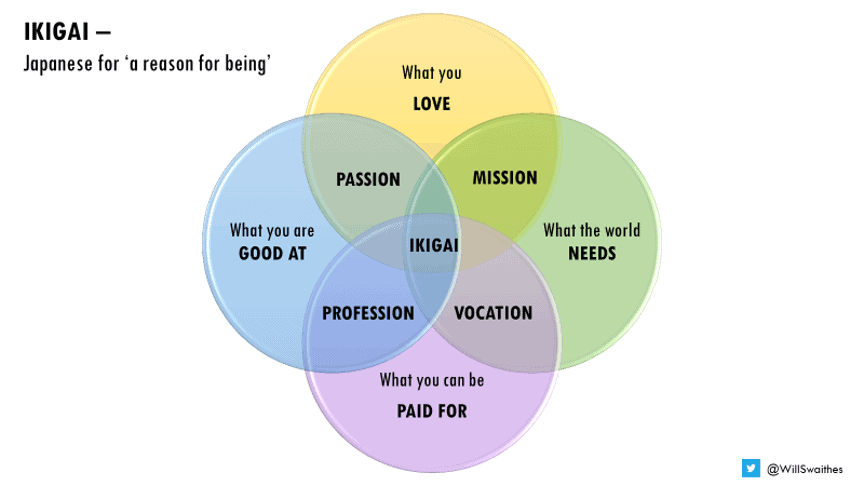
This quick blog introduces the idea of ikigai and signposts to a useful ‘planning for purpose’ self-review worksheet for educators.
I am a great believer that happy people are productive people. And with that comes achievement as well as satisfaction. That is not to say that we can avoid failures or always be happy, but I truly believe that a good place to start is to carefully consider what aspects of work (and life) make you happiest and then seek ways to do more of that. Of course every job has its frustrations, with paperwork and assessment high on the list for most teachers but which bits of the job really light your fire?

Understanding what makes individuals happy and hence thrive in the workplace is also the approach I have adopted when leading teams. Completing a Myers-Briggs, VIA Character Strength Survey or 5 voices assessment is a great way to understand your team but so too is this ikigai framework. As a consequence you can effectively cater for individual preferences, structure team meetings accordingly and most importantly issue roles and responsibilities (either formal or informal) based on what different people get most satisfaction from. Some love the opportunity to convert “PE haters” to engaged lifelong participants. Others get their buzz from unlocking future careers in the PE and sport industry through exam group teaching. Others still get their kick from 100’s of fixtures a year and supporting sports team performance. If you assume everyone just wants a small slice of all of the above you might be missing a real trick in terms of getting and giving more to the same group of staff.
So, ikigai (pronounced ick-e-guy), a Japanese word that means ‘reason for being’ or why you jump out of bed in the morning. For those who haven’t come across this concept before, here is a whistle stop tour.

It is a Venn diagram that helps you think about what you love doing, what the world needs, what you can be paid for and what you are good at.
For me, the true genius comes when you start exploring the overlap zones – I think we all show passion for teaching PE because we love it and are fairly good at it, otherwise you probably wouldn’t be the sort to invest in reading this blog!
Mission is where what you love meets what the world needs, so many in education can be considered missionaries but what is it that you are on a mission to achieve?
I know we all talk of teaching as a vocation… we get paid for it, although maybe not as much as some parents struggling with home schooling in 2020 have suddenly realised we are worth but, it is certainly more a way of life than a 9-3.
I talk with trainee teachers about learning the craft of teaching, there is certainly a need to be good at it if you are going to continue to get paid in the profession. And then we have the sweet spot in the middle, your ikigai, the holy grail and the place we all want to be.
The worrying bit is the four zones near the centre, where you have not quite found your true purpose. Zone 1 is where you feel delight and fulfilment but don’t earn a lot. Zone 2 is exciting but there is a risk of complacency and uncertainty. Zone 3 is a comfortable place to be and I would suggest lots of teachers end up here but at the same time feeling a little empty. Zone 4 is a satisfying place to be but perhaps does not really contribute to the big picture.
This leaves me with a few big questions:
- Have you found your true purpose?
- Do your principles, philosophy for education, ideologies, current school context and role get you in your sweet spot?
- If you are responsible for leading and managing other staff, are you supporting them to operate in their unique sweet spot?
If you would like to find out more, consider these two books that I found helpful – ikigai by Hector Garci, the little book of ikigai by Ken Mogi. I would also massively recommend the infinite game by Simon Sinek to help in thinking about the bigger picture and risks of a zero-sum game.
Access the following template to ‘plan for purpose’ and help explore how to get the best out of yourself. For those with leadership responsibility, why not get each member of your team to complete this template and incorporate it as part of your performance management/ appraisal conversations or New Year Resolutions with your team?



Responses